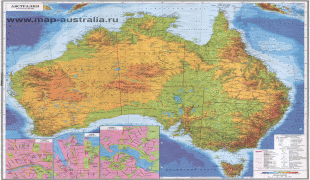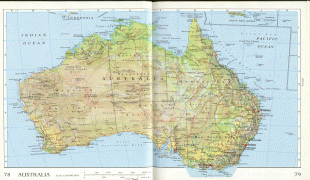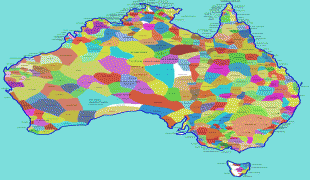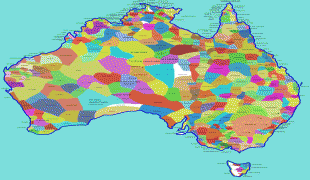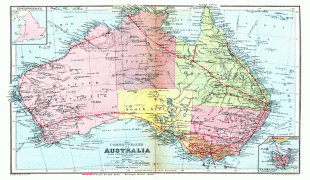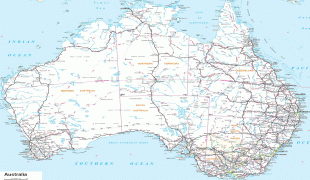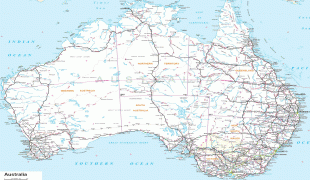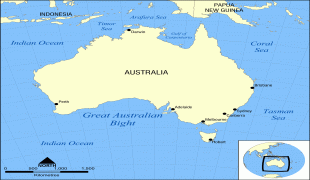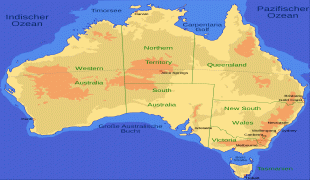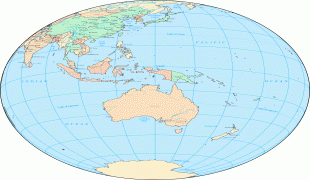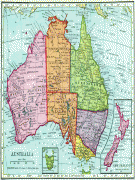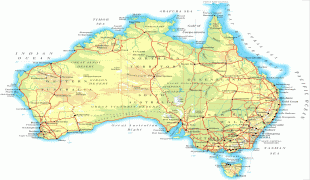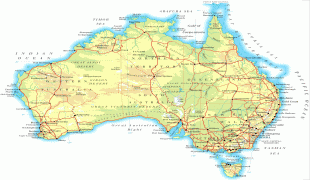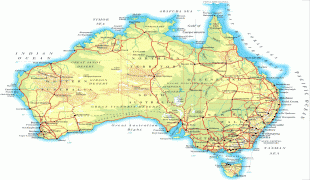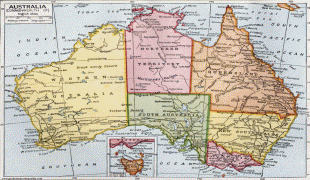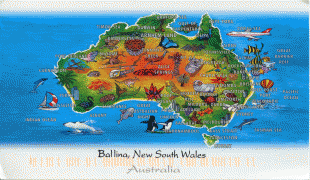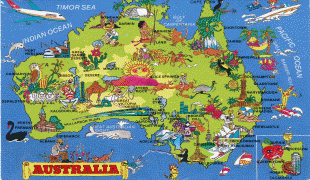Australia (Commonwealth of Australia)
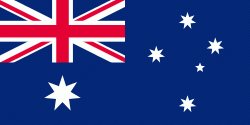 |
 |
| Flag of Australia | |
The ancestors of Aboriginal Australians began arriving from south east Asia approximately 65,000 years ago, during the last ice age. Arriving by sea, they settled the continent and had formed approximately 250 distinct language groups by the time of European settlement, maintaining some of the longest known continuing artistic and religious traditions in the world. Australia's written history commenced with the European maritime exploration of Australia. The Dutch navigator Willem Janszoon was the first known European to reach Australia, in 1606. In 1770, the British explorer James Cook mapped and claimed the east coast of Australia for Great Britain, and the First Fleet of British ships arrived at Sydney in 1788 to establish the penal colony of New South Wales. The European population grew in subsequent decades, and by the end of the 1850s gold rush, most of the continent had been explored by European settlers and an additional five self-governing British colonies established. Democratic parliaments were gradually established through the 19th century, culminating with a vote for the federation of the six colonies and foundation of the Commonwealth of Australia on 1 January 1901. Australia has since maintained a stable liberal democratic political system and wealthy market economy.
Politically, Australia is a federal parliamentary constitutional monarchy, comprising six states and ten territories. Australia's population of nearly million is highly urbanised and heavily concentrated on the eastern seaboard. Canberra is the nation's capital, while its most populous city and financial centre is Sydney. The next four largest cities are Melbourne, Brisbane, Perth, and Adelaide. Australia's demography has been shaped by centuries of immigration: immigrants account for 30% of the country's population, and almost half of Australians have at least one parent born overseas. Australia's abundant natural resources and well-developed international trade relations are crucial to the country's economy, which generates its income from various sources including services, mining exports, banking, manufacturing, agriculture and international education.
Australia is a highly developed country with a high-income economy. As of 2022, it was the world's fourteenth-largest economy with the ninth-highest per capita income. In 2021, it ranked as fifth-highest Human Development Index. Australia is a regional power, and has the world's thirteenth-highest military expenditure. Australia ranks amongst the highest in the world for quality of life, democracy, health, education, economic freedom, civil liberties, safety, and political rights, with all its major cities faring exceptionally in global comparative livability surveys. It is a member of international groupings including the United Nations, the G20, the OECD, the WTO, ANZUS, AUKUS, Five Eyes, the Quad, APEC, the Pacific Islands Forum, the Pacific Community and the Commonwealth of Nations.
The name Australia (pronounced in Australian English ) is derived from the Latin Terra Australis ("southern land"), a name used for a hypothetical continent in the Southern Hemisphere since ancient times. Several sixteenth century cartographers used the word Australia on maps, but not to identify modern Australia. When Europeans first began visiting and mapping Australia in the 17th century, the name Terra Australis was naturally applied to the new territories.
Until the early 19th century, Australia was best known as New Holland, a name first applied by the Dutch explorer Abel Tasman in 1644 (as Nieuw-Holland) and subsequently anglicised. Terra Australis still saw occasional usage, such as in scientific texts. The name Australia was popularised by the explorer Matthew Flinders, who said it was "more agreeable to the ear, and an assimilation to the names of the other great portions of the Earth". The first time that Australia appears to have been officially used was in April 1817, when Governor Lachlan Macquarie acknowledged the receipt of Flinders' charts of Australia from Lord Bathurst. In December 1817, Macquarie recommended to the Colonial Office that it be formally adopted. In 1824, the Admiralty agreed that the continent should be known officially by that name. The first official published use of the new name came with the publication in 1830 of The Australia Directory by the Hydrographic Office.
Colloquial names for Australia include "Oz" and "the Land Down Under" (usually shortened to just "Down Under"). Other epithets include "the Great Southern Land", "the Lucky Country", "the Sunburnt Country", and "the Wide Brown Land". The latter two both derive from Dorothea Mackellar's 1908 poem "My Country".
Currency / Language
| ISO | Currency | Symbol | Significant figures |
|---|---|---|---|
| AUD | Australian dollar | $ | 2 |
| ISO | Language |
|---|---|
| EN | English language |






